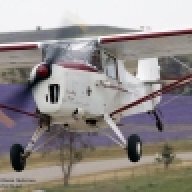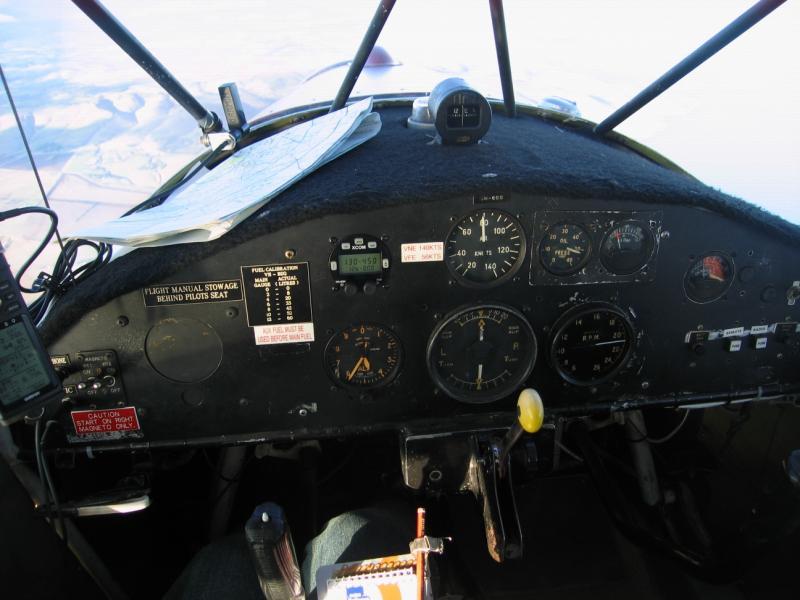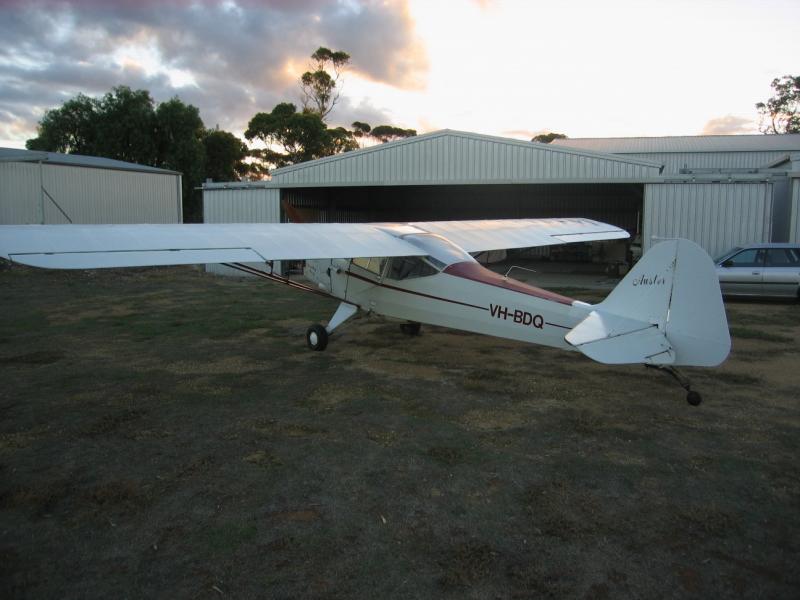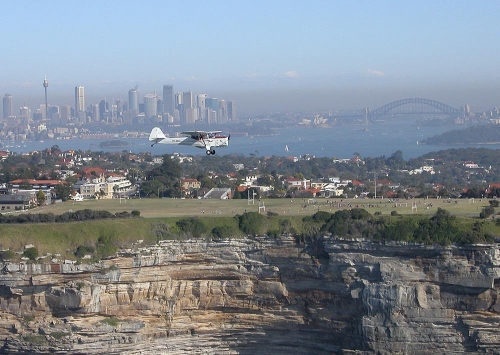-
Posts
214 -
Joined
-
Last visited
Content Type
Profiles
Forums
Gallery
Downloads
Blogs
Events
Store
Aircraft
Resources
Tutorials
Articles
Classifieds
Movies
Books
Community Map
Quizzes
Posts posted by Coop
-
-
Nice one Kaye. I've done a few hours in Grummans- nice machines, once you get used to the castering nosewheel.
I have to say, tho', that I've never seen it rain at Mildura!
The laptop in the cockpit and calling up the BOM radar website is a neat trick. Might have to investigate organising something like that myself.
Sounds like you had a lot of fun!
Coop
-
It struck me as a bit of a beat-up. I was quite taken by the shot of the little girl with the plane flying overhead (cue music from "Jaws").
I chuckled when I saw "abeam" being translated as "a bang". What did they think the overseas pilots had come here for?
There is a bit of a problem, tho'. I occasionally hear some folks who obviously don't have english as their first language, and they can be hard to understand- especially if they get away from standard phraseology. Most of the time they get by- but I don't fly much these days near crowded airports like Parafield and I guess it gets a bit testy there at times when crisp, clear communications are needed to keep them from banging into each other (maybe that's what they thought "a bang" was about?)
Coop
-
She looks a lot better than that now, with her newly painted wings...If you see her again, ask someone to point me out to you, and I'll give you a closer look... MUCH closer...G'day Coop,Thanks for the trip report and photos. Always good to see an Auster, on the ground or flying.[ATTACH]383[/ATTACH]
[ATTACH]384[/ATTACH]
This one looks the part, saw it at the Auster fly in at Wentworth in 2007.
Love to see them. Didn't get much time to do many pics myself, and of course, Dorothy couldn't make it...:frown:Just joined the AAAA and had excellent access at Echuca, a shame we were blown away by the weather. I am gradually putting my Echuca photos (along with Boort and others) on the gallery.Coop
-
Haven't managed to perform that aerobatic yet... maybe I need more practice...Secretary of our Aero Club has a 1948 Auster VH-KSN. HAve been in it a few times. Even got some video of it -Coop
-
The IAS is 80 kts. The actual cruise speed is closer to 90 kts (about 88 at last check at this altitude).The Auster is such a grand ol' Lady - there is a bright yellow one hangared here in YBLT, although never having spent any time in one, I love them, or at least the look and sound of them!It looks as though you are sitting on 80kt in the picture - is that the cruise speed generally? What sort of fuel burn would you get at that speed?Im surprised at the simplicity of the panel...but then I guess its all you need and quite adequate!
For some reason, never satisfactorily explained to me, many Auster models have significant "position errors" in their ASI setups, such that they under-read significantly at the higher end. Combine that with some differences due altitude (ie higher TAS at higher altitude for given IAS) and you get these significant errors. Fuel burn in my Auster is almost exactly 30 litres per hour- a very convenient figure for mental arithmetic!! For that, we get a 90 kt cruise, a 33kt stall speed (clean, 25kt with full flap) and enough payload that we can legally carry two crew, full fuel and about 20 kgs of luggage. That gives us about 4 hours of flying before the tanks are dry.
Coop
-
Thanks for your comments.
Show up at any Antique Aircraft Association of Australia (AAAA) fly-in and make your wishes known to the folks at the registration desk. It's quite likely that someone will be willing to make your dream come true. Lots of Austers attend the annual national rally, and of course plenty turn up at the annual Auster rally (next one's in Broken Hill in October).
Regards
Coop
-
For those of you who are interested in what Dorothy's antique instrument panel looks like, here it is:
[ATTACH]341.vB[/ATTACH]
Just the basics- although even this has more than most. For example, oil temp and cylinder head temp guages are optional on Austers. Most don't have them. The big blanked hole on the left is where the DG used to live- but it's bearings had worn out so it just played ring-a-ring-a-rosie, and I removed it to save weight. Fixing it would probably cost a small fortune.
The big dial with the two needles in the centre (behind the throttle lever) is the turn and slip-skid indicator. I've actually flown Dorothy for about half an hour under the hood using this basic blind-flying instrument, and believe me, I have much greater respect now for those that did it for keeps back in the old days! It was hard work- and I was sweating within 15 minutes.
We have two fuel tanks, but only one fuel gauge- just visible behind the compass. It gives a rough idea of the amount of fuel in the front (main) tank (in imperial gallons) but we pay it scant attention- unless it is telling us bad news- and go by time only. The belly (auxilliary) tank has no gauge, we just run it for one hour and fifty-five minutes, or until the engine coughs- whichever occurs first.
The only other instrument is the Garmin89 GPS (just visible at left). There is only one lever- the throttle. There is no mixture control (Dorothy runs in full rich at all times) and no pitch control (fixed pitch wooden prop).
Although the placard says "Flight Manual Stowage Behind Pilot's Seat" that is a lie- there is no flight manual for this model. There is a certificate of airworthiness that gives the basic information you need such as empty weight, max gross weight, and a few other relevant bits of information. There is no "P-Chart", and no C of G chart (in its original configuration, to get it outside its C of G range you would have to overload it). I've created a C of G chart from the figures derived from a recent weighing, but little has changed- you have to do ridiculous things to Dorothy to get her outside the C of G range without actually overloading her.
So the flying is simple. Chuck the luggage in and swing the prop. If there is a loud noise coming from the front, then the engine must be running, if the wheels have stopped turning, then we have some altitude, and if it all goes quiet, we have run out of fuel...
Coop
[ATTACH]17878[/ATTACH]
-
Flew to KI on the weekend. Here are a few pics:
THe weather was unusually calm, and had been for some days. The result was an incredibly glassy surface, resulting in this image of the sky reflected off the sea in Neapean Bay. You can also see the bottom of the bay through the water.
[ATTACH]339.vB[/ATTACH]
On the return trip, the cloud was creating two layers, a scattered one below and a more complete one above (although there were still blue patches). I had fun flying over the lower layer, and this put me high enough (4,500') to feel comfortable crossing the 10 miles of water separating the Island from the mainland. The altitude would be enough to get me to land should Dorothy's engine suffer a heart attack in the middle of Backstairs Passage.
[ATTACH]338.vB[/ATTACH]
Once above the lower cloud, I spotted a circular rainbow around Dorothy's shadow.
[ATTACH]337.vB[/ATTACH]
Cape Jervis stood out well in the late afternoon sunshine- the Ferry terminal is at the bottom left of the picture and the Starfish Hill wind turbine installation is also visible. In spite of the low winds, these big blades were still ticking over.
[ATTACH]336.vB[/ATTACH]
The run home was also entertaining, with the layers of cloud below thickening up somewhat, and a bit of ducking and weaving was needed to stay in clear air (but always with one eye on an escape route out to the east over lower ground). Dorothy's newly-painted wings looked good in the evening light before I put her away for the week.
[ATTACH]340.vB[/ATTACH]
Coop
[ATTACH]17877[/ATTACH]
-
Don't worry, I told him as I disembarked.... :tongue:
Coop
-
It's a good feeling when you get one right, isn't it Jack?
The pilot of the Sharp Metroliner to Port Augusta last week managed a very smooth touchdown- so good, in fact, that it was hard to tell when the wheels actually settled onto the tarmac, and the sleeping passenger just ahead of me only woke up when the reverse pitch came on.
Now that's smooth!!
Coop
-
Yeah, don't we know it. DROVE to Echuca...... but at least the farmers are smiling.
Coop
-
Delightful story, sixties. It's amazing how quickly one can move when a ride in a classic aircraft is on offer, eh?
What's behind the starter pedal? A huge electrical switch? A clutch? Something hydraulic?
Coop
-
-
I'm going for the coincidence theory. The C-47 (modified DC-3 with bigger doors and strengthened floor) was ordered in 1940. The first Jeep came off the production line in September 1940 (apparently). I think it would be much too presumptuous to suggest that the powers that be could have brought these two ideas together in their minds and thought: "Hmmm.... if we make the doors just so big, we'll be able to squeeze the Jeeps through and take them to the battle field......"The WW2 Jeep fits nicely through the cargo doors of a C47 .. BUT .... was the Jeep sized so as to suit the C47 door width, or was the C47 door width made to suit the Jeep?[or maybe - it was nothing more than a serendipitous coincidence?]
Nah. Lucky coincidence.
Coop
-
Well, you are right about the pushing and shoving. See here:I believe a larger cargo door was added. I can't see how a jeep would fit in without some pushing and shoving to accomodate it so I will go with a coincidence.http://cas.awm.gov.au/photograph/P03698.011
Coop
-
Love that first shot! Nice Timing!
Cripes, what a tangle of aircraft....
Coop
-
I wonder if the hangars at Temora are tall enough to fit the tail of a Caribou?
Coop
-
I guess the answer is quite simple: it's called politics...They also investigate on how come Garuda is still flying in Australia when it has a history of major accidentsCoop
-
Yep, I know all about that! Refuelled the Pawnee one day (D-model with wing tanks) and placed the cap on the top of the filler neck, but didn't secure it because I only had one hand free (the other was holding the nozzle) and it took two hands because it was very tight. You can guess the rest.....Lol, thanks Ozchris and Coop.about that preflight inspection, when i turned downwind i actually checked that the fuel caps were still screwed on hahahahaha. i don't know why i thought it but i did check it lolThe cap came off during the descent and a nice stream of avgas trailed out behind me. Only lost a couple of litres but it looked like gallons! Never made that mistake again....
Coop
-
Certainly nothing to do with cross-winds. Airliners fly straight through the air except when landing in cross-winds. To do anything else would chew up large amounts of extra fuel! I think fuel vapour venting is the most likely explanation. I'd be surprised if variations in humidity would be so sharp at that altitude as to give a vortex contrail from one wing and not the other. You could get this effect close to the ground where there might be significant variations in humidity over short distances (such as a wingspan) as a result of turbulence.
Coop
-
Derrin,
Hiv yew hed eny lingwidge training prior to your move to new Zuland? :-)
Good luck in Kiwi-land,
Coop
-
Very detailled post, Jack. You are obviously enjoying it or you wouldn't remember it so clearly.
If you have access to where the aircraft are serviced, it's a good idea to have a chat to some of the LAME's (if they aren't too busy) and ask them what to look for in your pre-flight inspections. They are the ones who fix the bugs, so they will know about the common faults that are likely to turn up. For example, I always check the exhaust stud nuts-even the ones I can't see (by feel- assuming the engine is cold) because in my flying career I would have had about half a dozen occasions where these have worked loose, come off entirely, or where the stud itself has broken off.
Be especially diligent when pre-flighting an aircraft that has just come out of an inspection. Engineers are only human and they can make mistakes, like failing to secure all the screws on an inspection port (a recent example), or not latching a luggage locker properly. I've even pre-flighted a Pawnee after a wing had been re-covered with fabric and found a missing bolt in the jury struts!! (THe engineer turned pale when I showed him!).
Don't feel too bad about the mess in the circuit- most of us have done something like that at one time or another. I once reported myself to be west of the field when I was actually east.....and I've watched experienced commercial pilots make similar errors.
Keep up the "rubbernecking". Looking forward to your next report,
Regards
Coop
-
Great shots, Glenn. Specially liked the shots of the "dump".
Rain that doesn't hit the ground is called "virga". If it hits the ground it loses its virga title, and if it hits the ground a lot it's called "slutta".....
Coop
-
Yes, it is a great feeling. But be aware that this can get you disoriented. Staring at the ground can induce you to wind into a spiral dive. A glance at the horizon every few seconds and a glance across the turn helps ensure this doesn't happen. Your instructor will certainly take you through this especially when you start doing steep turns.The best part when you are just flying around is when you are in a turn looking down at the things on the ground, for me that is just the greatest feeling, knowing that YOU are controling this aircraft and you ARE flying, not just dreaming.Sounds like you are having fun. There may come a time where you think you are not making any progress, and many people get discouraged when this occurs. In fact, most people are making progress at this time, but they don't notice because their developing ability to do what they want to do lags behind their developing ability to recognize what they should be doing. It's a transitional phase between doing things by thinking about them (like you are now) and doing things "automatically". Most of us have been through it in our training.
Keep up the reports- brings back memories...
Coop






My new baby
in Aviation Enthusiasts
Posted
Sorry to put a damper on things but we lost an innocent bloke over here a couple days ago. He was just moseying along in his car with his girlfriend and got cleaned up by two Subaru WRX's that were dragging...... Cut his car in half, killed him and critically injured his girlfriend. The drivers of the two Subaru's have both been charged with causing death by dangerous driving, and I am willing to lay odds they will both do jail time. But that won't be the worst of it- they'll have to live with their stupidity for the rest of their lives.
So Robbo and Darren (and maybe others), I like the look of the car- and it'll be great for towing your R22 on its trailer, but please, please, save the dragging for the race track. Otherwise, the person you kill might be one of us....
Coop